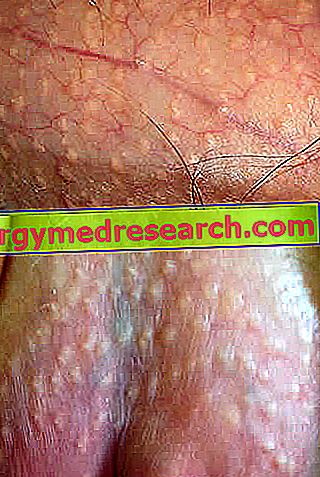Generality
The granules of Fordyce are small sebaceous glands with atypical site, not associated with hair follicles and lacking any communication with the outside.
Almost physiological phenomena affecting a large part of the population, Fordyce granules have the appearance of blotches or protuberances, white-yellow or red in color and with dimensions between 1 and 3 millimeters.

Fordyce granules in the penis (top) and in the vulva (bottom)
The most common sites of formation of Fordyce granules are: the genitals (body of the penis and scrotum, in men, and vulva, in women), some parts of the face, lips of the mouth and oral mucosa.
Except for representing a certain aesthetic discomfort, Fordyce granules are generally free of symptoms: they are not painful, they are not itchy, they are not the manifestation of infections etc.
Diagnosis is immediate and requires only physical examination.
According to the doctors, the use of a therapy is superfluous; however, if they represented a flaw for the patient, therapeutic solutions are not lacking.
What are Fordyce granules?
The granules of Fordyce are small ectopic sebaceous glands, which tend to appear on the genitals (body of the penis and scrotum, in men, and vulva, in women), in some parts of the face, on the lips of the mouth and on the oral mucosa.
Also known as Fordyce stains or sebaceous protuberances, Fordyce granules can appear as white-yellow or red spots or bumps, and between 1 and 3 millimeters in size.
Meaning, word by word, of ectopic sebaceous gland
- Gland : it is an organ or a set of cells with the capacity to produce a particular substance, which in technical jargon is called secretion.
In the human body, there are the endocrine glands, which discharge their secretions (hormones) into the circulatory stream, and the exocrine glands, which, unlike the previous ones, pour their secretions outside the body (ex: sweat glands).
- Sebacea : it is the adjective that refers to sebum, a fatty, fatty substance.
- Ectopica : in medicine, a biological circumstance (eg pregnancy) or an organ (eg kidney) is defined with the adjectives "ectopic" or "ectopic", which has a different seat than the traditional and correct one.
- Sebaceous gland : it is an exocrine gland, located in the dermis and joined to the hair follicle, which produces sebum, which has a lubricating function towards the skin, hair and hair.
- Ectopic sebaceous gland : it is a sebaceous gland that is always found in the dermis, but which, unlike a normal sebaceous gland, is not joined to the hair follicle and lacks a duct for communication with the outside.
Origin of the name
Fordyce granules owe their name to John Addison Fordyce (1858-1925), the US dermatologist who described them clinically for the first time in a reliable medical journal.
Fordyce also owes the terms of: Fox Fordyce disease, Fordyce disease, Fordyce injury and Brooke-Fordyce trichoepithelioma.
Epidemiology
So many people develop Fordyce granules. Consider that, according to some estimates, 80% of the general population would present at least one granule of Fordyce at the level of the oral mucosa.
Fordyce granules are as common in males as in females.
In children under the age of 3, their presence is quite rare; after that, it becomes progressively more marked.
Causes
Although they are sebaceous glands with abnormal, wrong localization, Fordyce granules do not represent the clinical sign of any particular disease or infection . According to the doctors, they are natural events, almost physiological and, certainly, devoid of any pathological nature.
Symptoms and complications
Generally, Fordyce granules do not cause pain or itching .
On the genitals, they tend to look like red or pink-red papules ; on the lips and on the labial mucosa, on the other hand, they resemble small white-yellow rice grains .
Occasionally, adjacent Fordyce granules can fuse together, forming something very similar to what results from the processes of sebaceous hyperplasia of the skin. If the fusion of the granules is in a point visible to all, it can be a reason for a certain aesthetic discomfort ; however, the resulting formation always remains painless and not itchy.
In some individuals, squeezing the granules of Fordyce causes the release of a liquid of calcareous nature from the latter.
Fordyce granules on the male genitals
Generally, the Fordyce granules that cover the body of the penis are revealed when the skin is stretched, as happens for example during an erection.
Fordyce granules on the lips
At the external labial level, the Fordyce granules form above all on the edge of the vermilion of the upper lip . The border of the vermilion of the lips is the line that separates the normal skin from the pink-red region, which surrounds the mouth above and below.
Fordyce granules on the oral mucosa
Inside the mouth, Fordyce granules form more frequently on the mucous portion of the lips, on the so-called retromolar trigone and on the tonsillar area.
In some individuals, they are present in hundreds; in other subjects, on the other hand, they are present in extremely small numbers (a couple at the most).
Complications
The only complications - if you want to call them that - related to the presence of Fordyce granules are:
- The aforementioned aesthetic discomfort, which, for some, may also derive from a few granules of Fordyce, if these are located in “uncomfortable” points of view (eg: border of the vermilion of the upper lip);
- The totally unfounded concern of suffering from some sexually transmitted disease, a concern that obviously follows from the presence of Fordyce granules on the genitals.
In general, this fear is resolved when the doctor is contacted and the problem is exposed.
CAN MALYAN CANCERS ARISE FROM THE GRANULES OF FORDYCE?
Although it is an extremely remote possibility, a particular type of malignant neoplasm, known as sebaceous carcinoma, can develop from Fordyce granules.
Diagnosis
Making a diagnosis of Fordyce granules is very simple and requires only physical examination .
Diagnostic criteria for Fordyce granules:
- They are sebaceous glands, exactly like those of hair follicles;
- They are not joined to any hair follicle;
- They reside in the dermis;
- Lacking a duct for communication with the outside;
- They occupy atypical sites for a normal sebaceous gland.
Therapy
Because they consider Fordyce granules an almost physiological phenomenon and because they are harmless, doctors tend to advise against the use of any type of treatment, especially in light of the fact that the therapies available today are only partially effective.
After this necessary premise, the therapeutic possibilities for those who want to try to eliminate Fordyce granules (and any resulting blemishes) are 4:
- The CO2 laser . It aims to make the Fordyce stains less visible. It is widely used in cosmetics;
- Electro-drying . It has the same purposes as the CO2 laser;
- The pulsed dye laser . Specifically indicated for the treatment of sebaceous hyperplasia, it seems to have a certain efficacy also against Fordyce granules.
Unfortunately, it has the drawback of being very expensive; this motivates the scarce utilization, in spite of the good results;
- The so-called Micro Punch technique . It is an innovative surgical treatment, which appears to provide excellent results, even in patients with many Fordyce granules.
Prognosis
Since these are benign, asymptomatic and devoid of any link with any pathological condition, Fordyce granules cannot but have a favorable prognosis.



